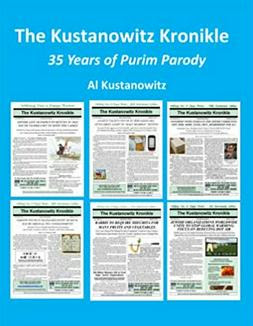"Almonds and Wine" brings a Yiddish folk song to life, as the animated
journey of a young bride and groom from Eastern Europe to North America
is set to rollicking klezmer music.
Fleeing the threat of war, the
couple arrive in Canada, establish a new life together and hand down
their traditions to the generations that follow. This film is set to a
classic Yiddish folk song, Di Mamme iz Gegangen in Mark Arayn (My Mother Went to Market.) It was produced, directed and animated by Arnie Lipsey.
The animation is inspired, but the characters move through the story so fast that you'll have to watch it more than once or keep your finger on the pause button to catch all of the details and read what's written on the store signs and protest signs.
How do we know that the couple settles in Canada and not the U.S.? Notice that the boy is running around with a hockey stick, not a baseball bat.
The depiction of the Jewish wedding ceremony is very detailed. Be sure to watch for the expression on the bride's and groom's faces when they are lifted onto chairs for the traditional handkerchief dance.
The Yiddish lyrics and English translation appear below the video. Enjoy!
(A SPECIAL NOTE FOR NEW EMAIL SUBSCRIBERS:
THE VIDEO MAY NOT BE
VIEWABLE DIRECTLY FROM THE EMAIL THAT YOU
GET EACH DAY ON SOME COMPUTERS AND
TABLETS. YOU MUST CLICK ON THE TITLE AT THE
TOP OF THE EMAIL TO REACH THE JEWISH
HUMOR CENTRAL WEBSITE, FROM WHICH YOU CLICK
ON THE PLAY BUTTON IN THE VIDEO
IMAGE TO START THE VIDEO.)
Oy di mamme iz gegangen in mark arayn noch keyln,
Oy hot zi mir tzurik gebracht a meydele fun Peyln.
Oy iz dos a meydele a sheyns un a feyns,
Oy Mit di shvartse eygelach, oy ketsele du mayns.
Oy di mamme iz gegangen in mark arayn noch kreyt,
Oy hot zi mir tzurik gebracht a meydele fun beyt,
Oy iz dos a meydele a sheyns un a feyns,
Oy mit di shvartse eygelach, oy ketsele du mayns.
Oy di mamme is gegangen in mark noch a katchke
Oy hot zi mir tzurik gebracht a meydele, a tzatzke
Oy iz dos a meydele a sheyns un a feyns,
Oy mit di vayse tzeyndelach, oy ketsele du mayns.
Ich hob gegesn mandlen, ich hob getrunken vayn,
Ich hob gelibt a meydele un ken on ir nisht zayn,
Oy iz dos a meydele a sheyns un a feyns,
Oy mit di roite bekelach, oy ketsele du mayns.
My mother went to market to buy some coal,
She brought me back a lovely girl from Poland.
Oh what a girl she was, how beautiful and fine,
Ah, those black eyes of hers, ah, you kitten of mine.
She brought me back a lovely girl from Poland.
Oh what a girl she was, how beautiful and fine,
Ah, those black eyes of hers, ah, you kitten of mine.
My mother went to market to buy some cabbage,
She brought me back a girl just off a coach.
Oh what a girl she was, how beautiful and fine,
Ah, those black eyes of hers, ah, you kitten of mine.
She brought me back a girl just off a coach.
Oh what a girl she was, how beautiful and fine,
Ah, those black eyes of hers, ah, you kitten of mine.
My mother went to market to buy a duck,
She brought me back a girl - what a handful!
Oh what a girl she was, how beautiful and fine,
Ah, those white teeth of hers, ah, you kitten of mine.
I have been eating almonds, I have been drinking wine,
And I have loved a lass and could not part from her.
O what a lass she was, how lovely and how fine,
Ah, those red cheeks of hers, ah, you kitten of mine.
And I have loved a lass and could not part from her.
O what a lass she was, how lovely and how fine,
Ah, those red cheeks of hers, ah, you kitten of mine.
(A tip of the kippah to Malka Edelman for bringing this video to our attention.)



















